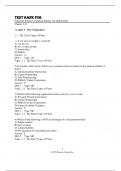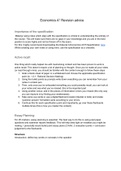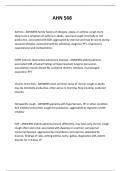Exam (elaborations)
Test Bank for Corporate Finance, Canadian Edition 5th Edition by Jonathan Berk, David Stangeland, Peter DeMarzo
Course
Corporate Finance, Canadian Edition 5th Edition
Institution
Corporate Finance, Canadian Edition 5th Edition
Test Bank for Corporate Finance 5ce 5th Canadian Edition by Jonathan Berk, Peter DeMarzo; David A. Stangeland. Chapter 1 The Corporation and Financial Markets Chapter 2 Introduction to Financial Statement Analysis Chapter 3 Arbitrage and Financial Decision Making Chapter 4 The Time Value of Money C...
[Show more]
Preview 4 out of 863 pages
Uploaded on
April 3, 2024
Number of pages
863
Written in
2023/2024
Type
Exam (elaborations)
Contains
Questions & answers
test bank for corporate finance
canadian edition 5th edition
jonathan berk david stangeland peter demarzo
Book Title: CORPORATE FINANCE, FIFTH CANADIAN EDITION.
Author(s): JONATHAN. STANGELAND BERK (DAVID. DEMARZO, PETER.)
Edition: 2021 ISBN: 9780136648802 Edition: Unknown
Exam (elaborations)
TEST BANK For Corporate Finance 6th Edition by Berk & DeMarzo All 1-31 Chapters Covered ,Latest Edition, ISBN:9780136648802
Exam (elaborations)
Test Bank for Corporate Finance, Canadian Edition 5th Edition by Jonathan Berk, David Stangeland, Peter DeMarzo
Exam (elaborations)
TEST BANK For Corporate Finance 6th Edition by Berk & DeMarzo, Verified Chapters 1 - 31, Complete Newest Version
All for this textbook (20)
Institution
Corporate Finance, Canadian Edition 5th Edition
Course
Corporate Finance, Canadian Edition 5th Edition
R316,92
100% satisfaction guarantee
Immediately available after payment
Both online and in PDF
No strings attached
1 © 2022 Pearson Canada Inc. Test Bank for Corporate Finance, Canadian Edition, 5th edition Berk Chapter 1-31 Chapter 1 The Corporation 1.1 The Three Types of Firms 1) A sole proprietorship is owned by: A) one person B) two or more people C) shareholders D) bankers Answer: A Diff: 1 Type: MC Topic: 1.1 The Three Types of Firms 2) In Canada, which of the following organization forms accounts for the greatest number of firms? A) Limited Liability Partnership B) Limited Partnership C) Sole Proprietorship D) Publicly Traded Corporation Answer: C Diff: 1 Type: MC Topic: 1.1 The Three Types of Firms 3) Which of the following organization forms earns the most revenue? A) Privately Owned Corporation B) Limited Partnership C) Publicly Owned Corporation D) Limited Liability Company Answer: C Diff: 1 Type: MC Topic: 1.1 The Three Types of Firms 4) Which of the following is NOT an advantage of a sole proprietorship? A) Single taxation B) Ease of setup C) Limited liability D) No separation of ownership and control Answer: C Diff: 2 Type: MC Topic: 1.1 The Three Types of Firms MEDCONNOISSEUR 2 © 2022 Pearson Canada Inc. 5) Which of the following statements regarding limited partnerships is TRUE? A) There is no limit on a limited partner's liability. B) A limited partner's liability is limited by the amount of his investment. C) A limi ted partner is not liable until all of the assets of the general partners have been exhausted. D) A general partner's liability is limited by the amount of his investment. Answer: B Diff: 2 Type: MC Topic: 1.1 The Three Types of Firms 6) Whic h of the f ollowing is/are an advantage(s) of incorporation? A) Access to capital markets B) Limited liability C) Unlimited life D) All of the above Answer: D Diff: 2 Type: MC Topic: 1.1 The Three Types of Firms 7) In Canada, a limited liability par tnership, LLP, is essentially: A) a limited partnership without limited partners B) a limited partnership without a general partner C) just another name for a limited partnership D) just another name for a corporation Answ er: B Diff: 1 Type: MC Topic: 1.1 The Three Types of Firms 8) In Canada, which of the following business organization forms cannot avoid double taxation? A) Limited Partnership B) Publicly Traded Corporation C) Privately Owned Corporation D) Limited Li ability Company Answer: B Diff: 1 Type: MC Topic: 1.1 The Three Types of Firms 9) In Canada, the dividend tax credit gives some relief by: A) effectively giving a lower tax rate on dividend income than on other sources of income B) effectively giving a higher tax rate on divide nd income than on other sources of income C) effectively giving the same tax rate on dividend income as on other sources of income D) effectively giving a tax rate of zero on dividend income compared to other sources of income Answer: A Diff: 1 Type: MC Topic: 1.1 The Three Types of Firms MEDCONNOISSEUR 3 © 2022 Pearson Canada Inc. 10) Which of the following statements is most correct? A) An advantage to incorporation is that it allows for less regulation of the business. B) An advantage of a corporation is that it is subject to double taxat ion. C) Unlike a partnership, a disadvantage of a corporation is that it has limited liability. D) Co rporations face more regulations when compared to partnerships. Answer: D Diff: 2 Type: MC Topic: 1.1 The Three Types of Firms 11) In Canada, the d istinguishing feature of a corporation is that: A) there is no legal difference between the corporation a nd its owners B) it is a legally defined, artificial being, separate from its owners C) it spreads liability for its corporate obligations to all share holders D) it provides limited liability only to small shareholders Answer: B Diff: 2 Type: MC Topic: 1 .1 The Three Types of Firms 12) Which of the following is/are subject to double taxation in Canada? A) Corporation B) Partnership C) Sole proprie torship D) Both A and B Answer: A Diff: 1 Type: MC Topic: 1.1 The Three Types of Firms 13) Canada Revenue Agency, CRA, allows an exemption from double taxation for certain flow through entities where all income produced by the business flows to the investors and virtually no earnings are retained within the business. These entities are called: A) Canadian Fed eral Crown Corporations B) Canadian Controlled Corporations C) Income Trust Corporations D) Foreign Controlled Corporations Answer: C Diff: 1 Type: MC Topic: 1.1 The Three Types of Firms MEDCONNOISSEUR 4 © 2022 Pearson Canada Inc. 14) In 2006, the Canadian government effectively neutralized the tax advantages that had existed for most income trusts, relative to firms set up as corporations. The advantages that existed for income t rusts prior to these changes were that: A) income trusts avoided double taxation in that the Canada Revenue Agency did not collect corporate taxes but rather collected only personal taxes from income trust unit holders B) income trusts effectively afforded unlimited liability to unit holders while corporate shareholders could face unlimited liability C) while double taxation existed for both income trusts and corporations, the net tax paid by income trust unit holders was in most cases less than that paid b y corporate shareholders D) the changes introduced in 200 6 eliminated double taxation for corporations, thereby making the taxation of income trusts and corporations substantially equivalent Answer: A Explanation: The 2006 changes imposed new taxes on mo st income trusts to mirror the total tax revenue received from corporations. As a result with no material tax advantage, these firms reverted from income trusts back to a corporate structure. The exception was Real Estate Investment Trusts (REIT) which a re exempted from the changes imposed on all other trusts. Diff: 2 Type: MC Topic: 1.1 The Three Types of Firms 15) One of the major characteristics of a limited liability partnership, LLP, in Canada is: A) the limitation on a partner's liability is only in cases related to actions of negligence by other partners or those supervised by other partners B) any partner will not be liable for his or her negligence at any time C) any partners will be only liable for other partners' negligence D) none of th e above Answer: A Diff: 2 Type: MC Topic: 1.1 The Three Ty pes of Firms 16) You own 100 shares of a publicly traded Canadian Corporation. The corporation earns $5.00 per share before taxes. Once the corporation has paid any corporate taxes that are due, it will distribute the rest of its earnings to its sharehold ers in the form of a dividend. If the corporate tax rate is 40% and your personal tax rate on (both dividend and non -dividend) income is 30%, then how much money is left for you after all tax es have been paid? A) $210 B) $300 C) $350 D) $500 Answer: A Explanation: EPS × number of shares × (1 - Corporate Tax Rate) × (1 - Individual Tax Rate) $5.00 per share × 100 shares × (1 - .40) × (1 - .30) = $210 Diff: 3 Type: MC Topic: 1.1 The Thre e Types of Firms MEDCONNOISSEUR







